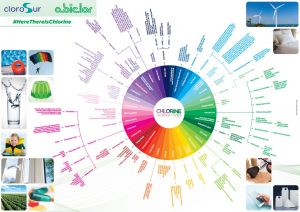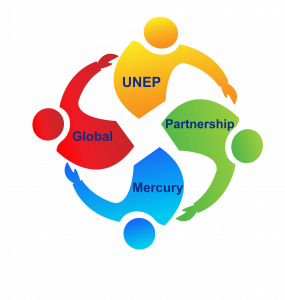The American Chemistry Council’s Chlorine Chemistry Division (CCD) traveled to Dallas, Texas to participate at the largest eco expo in the world. Tens of thousands of people gathered over the three-day public festival that aims to raise environmental awareness through innovation and progressive action.
More than 500 exhibitors gathered to share environmental-friendly knowledge and best practices from an array of platforms including the academic and government sectors. In 2015 the event’s media outreach garnered 23.2 million impressions from television, online, print and radio ads. The festival is free to both exhibit and attend.
CCD brought the fun back to chemistry with an experiment to demonstrate an endothermic reaction by making a cold pack using baking soda and citric acid. Children and adults of all ages learned the value of our industry and its innovations for a sustainable future.
In addition to participating in a popular chemistry experiment, kids and their parents took home thousands of Team Chlorine activity books. It was a tremendous success by showing attendees of all ages how chlorine chemistry drives progress on every front, including the environment, every single day. For example, few attendees knew that chlorine chemistry plays a surprisingly vital role in the production of solar panels and windmill turbine blades. And few knew that chlorine chemistry plays a surprising role in development of crop protection materials that supply a healthy and abundant food supply for families around the world.
You can learn more about the surprising role chemistry plays in everyone’s lives every day by visiting www.elementofsurprise.org.
 Chlorine and its co-product, caustic soda are applied in many essential substances and products that we rely on in our daily lives. From well known uses like water disinfection, through essential products like PVC to various intermediates in nylon and silicon production; chlorine and its co-products make our lives better.
Chlorine and its co-product, caustic soda are applied in many essential substances and products that we rely on in our daily lives. From well known uses like water disinfection, through essential products like PVC to various intermediates in nylon and silicon production; chlorine and its co-products make our lives better.
This is outlined in a set of excellent, colourful publications from South American, WCC member organisation Clorosur with input from Brazilian group Abiclor. These publications describe the essential uses of the substances as well as some general information on our industry.
Information is available on CHLORINE and CAUSTIC SODA; for further information and to download the brochures in English, Spanish or Portuguese:, check out the Clorosur website .
 A very successful technology conference was held in Moscow on 05 and 06 April 2016 on the theme of ‘Chlorine and its derivatives 2016: Best Available Techniques’.
A very successful technology conference was held in Moscow on 05 and 06 April 2016 on the theme of ‘Chlorine and its derivatives 2016: Best Available Techniques’.
More than 140 people from the Russian Federation, Belarus, Kazakhstan, China, India and Europe attended the special tenth anniversary RusChlor conference to discuss items including the industrial production of chlorine and its derivatives, to share information on how to safely transport chlorine and the raw commodities, equipment and instruments that are used in chlor-alkali production.
Arranged in co-operation between WCC member RusChlor, the JSC National Chlorine Safety Centre, the Russian Federation Ministry of Industry and Trade, Federal Service for Ecological, Technological and Atomic Supervision as well as the Russian Chemists Union; over 78 legal entities were represented from state-owned and private companies, government agencies, trade associations, engineering companies and scientific organisations.
The main technological and safety challenges to the industry were presented alongside information on those Best Available Techniques (BAT). A highlight of the event was the open discussion on safe transportation of chlorine, something which the WCC follows very closely.
For further information on the event contact jagud@chlorcentre.ru
 The World Chlorine Council (WCC) is pleased to announce Mr. John McIntosh, recent appointee to the position of Executive Vice President of Olin and President of Chemicals & Ammunition, as the new WCC Governing Council Vice-Chairman.
The World Chlorine Council (WCC) is pleased to announce Mr. John McIntosh, recent appointee to the position of Executive Vice President of Olin and President of Chemicals & Ammunition, as the new WCC Governing Council Vice-Chairman.
In May 2014, he was appointed the Senior Vice-President of Chemicals and Senior Vice-President of Operations in October 2010. In February 1999, Mr. McIntosh held the position of President of Olin’s Chlor Alkali Products Division. In this role, he had the overall operational responsibility of the Chlor Alkali Products Division whose headquarters are in Cleveland, Tennessee, USA. In August of 1998, he was named the Vice-President of Operations for Olin’s Specialty Chemicals operations. Earlier in 1998, he held the position of Vice-President of Manufacturing and Engineering for Chlor Alkali.
Mr. McIntosh joined Olin in 1977 and has worked in various roles in manufacturing and operations before being appointed President of the Chlor Alkali Products Division.
He currently serves on the Chlorine Chemistry Division Management Committee and has held chairman positions on both the Executive and Finance Committees, as well as numerous American Chemistry Council (ACC) leadership positions. Mr. McIntosh will assume Governing Council Chairman position for 2017 and 2018 when the Secretariat responsibilities will be administered by the ACC’s Chlorine Chemistry Division.
 The World Chlorine Council (WCC) has established a document library in order to support the United Nations Environment Programme (UNEP) Global Mercury Partnership.
The World Chlorine Council (WCC) has established a document library in order to support the United Nations Environment Programme (UNEP) Global Mercury Partnership.
This library contains all the collected information on correct handling, storage, disposal and reporting of mercury as well as some useful documents to support the decommissioning of mercury chlor-alkali plants, which is required by many international authorities.
Mercury has historically been used in the production of chlor-alkali and its responsible management is followed very closely by the WCC. As active participants in the UNEP Global Mercury Partnership, the WCC has provided information and expertise from its global members in order to protect the planet from this potentially hazardous metal. The partnership supports the work on the Minamata Convention which aims to control the global anthropogenic release of mercury and is made up of governments, NGO’s & industry.
All information is now presented on a dedicated section of the website and is available at
https://worldchlorine.org/publications/unep-chlor-alkali-mercury-partnership/
This is the title of a book written by Dr. Michael J. McGuire and edited by the American Water Works Association in 2013. It describes the fascinating history of chlorine use for drinking water disinfection in the United States of America. The chlorination of drinking water is accepted worldwide as an effective way to kill deadly pathogens; but at the turn of the 20th Century, adding chlorine to water was considered revolutionary, even heretical by science, until a courageous physician proved that it could be done.
Perhaps no other advancement of public health has been as significant. Yet, few know the intriguing story of how a (retrospectively) simple idea, disinfecting public water systems with chlorine could, in just 100 years, save more lives than any other single health development in human history.
Dr. McGuire’s book also tells how, during the American Civil War which started in 1861, waterborne disease killed more soldiers than bullets! How in 1915 child death rate in the US was at 10 per cent and up to 30% in some cities due to contaminated milk; and how life expectancy in the US was 47 years in 1900 but by 1984 this rose to 70 years all due to chlorination!
At the turn of the 20th century, most scientists and doctors called the addition of chloride of lime, a “poisonous chemical”, to public water supplies not only a “preposterous idea” but also an “illegal act”, until a courageous physician, Dr. John L. Leal, working with George W. Fuller, the era’s greatest sanitary engineer, proved that it could be done safely and effectively on a large scale.
This is the first book to tell the incredible true story of the first use of chlorine to disinfect a city water supply, in Jersey City, New Jersey, in 1908. This important book also corrects misinformation long-held in the historical record about who was responsible for this momentous event, giving overdue recognition to the unsung hero of the story, an unflagging champion of public health, Dr. John L. Leal.
Dr. McGuire gave an interesting, well received, presentation of this important book at the WCC New Delhi meeting of last October 15th.
– – Be part of the progress.
A famous Chinese saying goes; “one prospers in worry and hardship, and perishes in ease and comfort”. Do we choose to rest on our laurels or to listen to other voices and seek action? Its time to prepare for real change!
The China International Chlor Alkali Conference (CICAC), co-organised by China Chlor Alkali Industry Association and China Chlor Alkali Online, has been held annually since 2012. Each year, this Conference attracts more than 200 of the world’s best, credible and financially responsible chemical industrial manufacturers and equipment makers.
The conference has long been used as a platform for cooperation and exchange on market analysis and technology sharing between industrial organisation leaders, world class entrepreneurs and managers. At the same time, various business activities such as product exhibitions, customised promotional meetings, plant visits etc. are also carried out to support the conference.
Key themes at this year’s conference include technological, economic and policy information sharing from WCC member countries, the impact of the global fuel economy on the industry as well as several sessions the status and future of the Chinese Chlor Alkali industry.
The 4th China International Chlor Alkali Conference will take place in the Oriental Bay International Hotel, Beijing from 27-29 October 2015.
For more details, please visit http://www.ccaon.com/zt/CICAC2015_old/en/index.asp.
Worldwide, nearly 1.2 billion people live without electricity, something which many of us take for granted. Now, with a bit of ‘green’ thinking and a splash of chlorine chemistry, a Philippines-based non-profit group are doing their bit to bring affordable lighting to low-income houses. Winners of the 2015 Zayed Future Energy Prize, Liter of Light use old plastic bottles filled with water and chlorine to produce a 55-watt solar bulb to capture and refract sunlight – a device which has already illuminated 28,000 homes in Manila alone. Such technology was vital in the aftermath of the 2013 typhoon which had such a devastating impact on the Philippines. With further projects in India, Indonesia and Switzerland, they hope to install over a million of these lights worldwide by the end of the year and it is all thanks to innovation and a bit of chlorine chemistry.
In April, China, the world’s largest chlorinated paraffin manufacturer, held an international conference in Beijing to discuss the challenges faced by the industry. Co-organised by CCAIA, CCAON and Euro Chlor, representatives from across the WCC were in attendance and the conference discussed the state of the industry in Asia, North America and Europe as well as the regulatory issues impacting these regions. The benefits and risk management issues were also addressed with the hope that, with close cooperation, clarification on some of the incorrect views in academia and at a regulatory level regarding CPs could be obtained.
CP’s provide effective solutions in many applications and products used to improve people’s lives worldwide. At the same time, these products continue to be under high regulatory pressure in various parts of the world, unfortunately often due to political, rather than scientific reasons. Being organochlorines, CP’s are too easily associated with some of the more problematic organochlorines of the distant past, such as PCBs and ‘drins’. In addition, dioxins have not helped the image of organochlorines, despite the fact that they are naturally produced and have never been intentionally manufactured. Meanwhile, the knowledge of the toxicology, environmental fate and analytics of these products has steadily increased for two decades. The Conference was an excellent occasion for international CP producers to network and exchange international regulatory updates.
World Chlorine Council Contributes Viewpoint Paper on Water, Sanitation and Hygiene Goals to Copenhagen Consensus Center
 As part of the post-2015 United Nations development agenda, a new set of sustainable development goals (SDGs) has been submitted to the General Assembly by a UN Open Working Group on Sustainable Development and are now being considered as part of broader post-2015 discussions. The new goals will be established upon the foundation of the 2000-2015 UN Millennium Development Goals. Proposed goal #6 has particular significance to World Water Day 2015, celebrated on March 22: “Ensure availability and sustainable management of water and sanitation for all.”
As part of the post-2015 United Nations development agenda, a new set of sustainable development goals (SDGs) has been submitted to the General Assembly by a UN Open Working Group on Sustainable Development and are now being considered as part of broader post-2015 discussions. The new goals will be established upon the foundation of the 2000-2015 UN Millennium Development Goals. Proposed goal #6 has particular significance to World Water Day 2015, celebrated on March 22: “Ensure availability and sustainable management of water and sanitation for all.”
As part of their effort to evaluate the costs and benefits of the proposed goals, the Copenhagen Consensus Center produced a “Water and Sanitation Assessment Paper” concluding that “Regardless of location and income, providing water and sanitation passes a cost-benefit test,” but that the greatest relative benefit comes from serving rural communities and the poorest populations. An invited Viewpoint Paper by the World Chlorine Council notes that as part of safely managing drinking water services, a low but measurable chlorine level (single digit or less parts per million), known as a “chlorine residual,” is an effective indicator of the microbial safety of drinking water. The authors make the point that for as long as it is detectable in stored or delivered water, chlorine provides an ongoing barrier to new contamination that could spread waterborne illness, such as typhoid fever, cholera, dysentery and hepatitis A.
Chlorine-based disinfectants are strong allies in the global effort to achieve safe drinking water and sanitation goals. Water and sanitation goals contribute to several of the other proposed SDGs as well, including ending poverty (Goal #1), ensuring healthy lives and well-being (Goal #3), achieving gender equality (Goal #5) and promoting economic growth and productive, decent work (Goal #8).